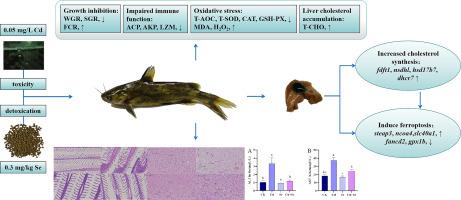硒可缓解镉对杂交黄颡鱼(Pelteobagrus fulvidraco♀ × Pelteobagrus vachelli♂)生长性能、氧化应激、胆固醇合成和铁下垂的影响。
IF 4.3
3区 环境科学与生态学
Q2 BIOCHEMISTRY & MOLECULAR BIOLOGY
Comparative Biochemistry and Physiology C-toxicology & Pharmacology
Pub Date : 2025-07-12
DOI:10.1016/j.cbpc.2025.110290
引用次数: 0
摘要
研究了硒代蛋氨酸(SeMet)对杂交黄颡鱼镉(Cd)毒性的缓解作用。设4组:对照组(CK)、镉组(Cd)、硒组(Se)和镉硒共处理组(Cd + Se)。结果表明,镉降低了鱼的特定生长率和增重率,提高了饲料系数比(P本文章由计算机程序翻译,如有差异,请以英文原文为准。

Selenium alleviates the effects of cadmium on growth performance, oxidative stress, cholesterol synthesis and ferroptosis of hybrid yellow catfish, Pelteobagrus fulvidraco ♀ × Pelteobagrus vachelli ♂
This research investigated selenomethionine (SeMet) alleviating cadmium (Cd) toxicity in hybrid yellow catfish. Four groups were established: control group (CK), cadmium group (Cd), selenium group (Se), and cadmium‑selenium co-treatment group (Cd + Se). The results demonstrated that Cd decreased the specific growth rate and weight gain rate of fish while increasing the feed coefficient ratio (P < 0.05). It also induced severe gill and liver tissue damage. Se alleviated Cd-induced growth inhibition, repaired the tissue damage, and reversed Cd-triggered increase of serum alanine aminotransferase and aspartate aminotransferase (P < 0.05). Regarding antioxidant capacity, Se reversed Cd-induced declines in total antioxidant capacity, total superoxide dismutase, catalase, and glutathione peroxidase activities, while mitigating hydrogen peroxide and malondialdehyde accumulation in the liver, gill, and serum (P < 0.05). Immunological analysis indicated that Cd suppressed lysozyme, acid phosphatase, and alkaline phosphatase activities, while Se restored these enzymatic activities to normal or higher levels (P < 0.05). Metabolic analysis revealed that Se reduced liver total cholesterol content in the Cd-exposed group and restored serum cholesterol to normal levels (P < 0.05). Furthermore, transcriptomic results demonstrated that Se antagonized Cd toxicity through dual regulatory mechanisms: (1) restoring the genes of iron metabolism (steap3, ncoa4) to control levels and upregulating the cystine/glutamate transporter system (Xc-system) gene slc3a2b, thereby protecting cells from ferroptosis; (2) downregulating cholesterol synthesis genes (msmo1, sc5d), thereby blocking Cd-induced aberrant cholesterol synthesis. These molecular findings aligned with physiological indicators, demonstrating that Se mitigated Cd toxicity in fish via a multi-target regulatory mechanism.
求助全文
通过发布文献求助,成功后即可免费获取论文全文。
去求助
来源期刊
CiteScore
7.50
自引率
5.10%
发文量
206
审稿时长
30 days
期刊介绍:
Part C: Toxicology and Pharmacology. This journal is concerned with chemical and drug action at different levels of organization, biotransformation of xenobiotics, mechanisms of toxicity, including reactive oxygen species and carcinogenesis, endocrine disruptors, natural products chemistry, and signal transduction with a molecular approach to these fields.

 求助内容:
求助内容: 应助结果提醒方式:
应助结果提醒方式:


